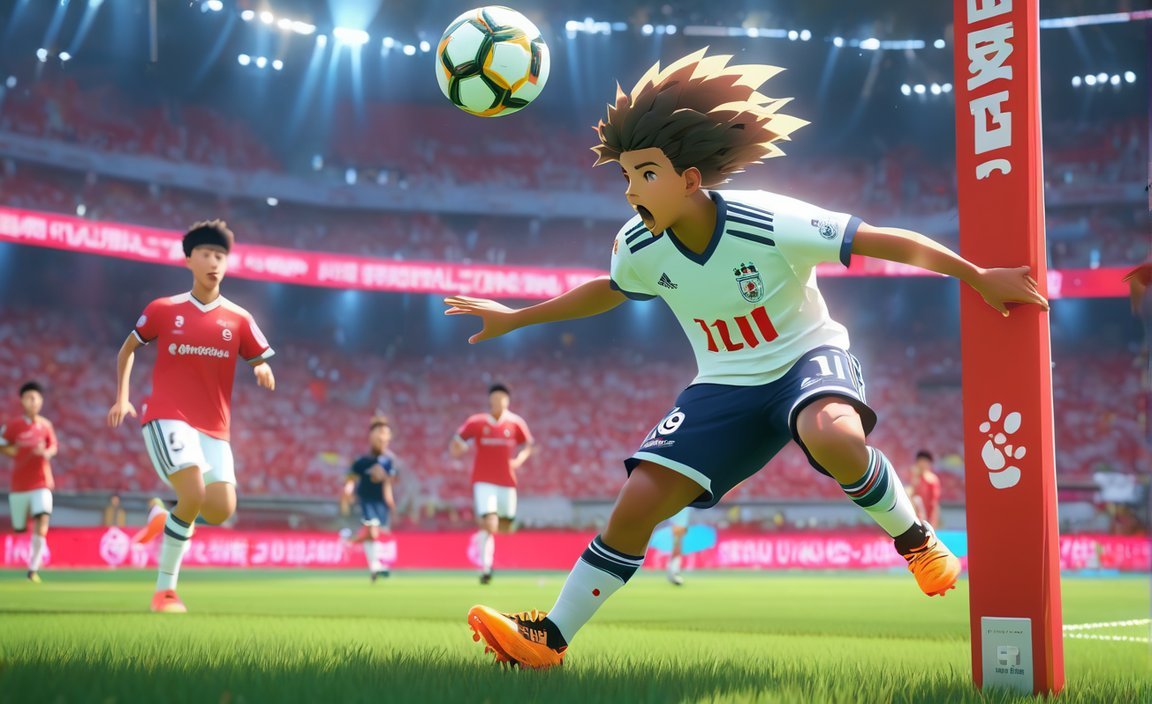Flag route football, a breathtaking display of tactical finesse and precision, remains an elusive art that only the most astute athletes and coaches fully comprehend. In this captivating analysis, we delve deep into the intricacies of flag route football, unearthing the secrets behind this exhilarating play. From unraveling the strategic brilliance of the quarterbacks to dissecting the nimble footwork of receivers, our journey into the heart of flag route football promises to demystify this captivating aspect of the game. Join us as we explore the nuances, techniques, and strategies that fuel this electrifying sport, and gain a profound appreciation for the audacity of those who dare to master flag route football.
Key Takeaways:
- Flag route is a deep vertical pass pattern in flag football that involves the receiver sprinting straight ahead before veering towards the sideline, resembling a flag.
- Offensive success in flag football relies on effective execution of flag football plays and formations, with quarterbacks making quick and accurate throws to exploit defensive weaknesses.
- Defensive tactics in flag football involve defensive backs studying offensive formations and routes to anticipate opponent’s moves and break up plays.
- Using the right flag football plays and formations can give the offense an advantage over the defense and create scoring opportunities.
- Additional resources like Football Advantage and The Champ Lair provide detailed explanations and 7 on 7 flag football plays for further understanding and improvement.
- Understanding the flag route and other routes from the route tree is crucial for offensive success in flag football.
- Defensive tactics play a significant role in disrupting offensive routes and covering receivers in flag football.
- By studying and implementing various flag football plays and formations, teams can enhance their potential and increase their chances of winning.
Flag Route Football: Mastering the Art of Vertical Precision

Flag Route in Flag Football
The flag route is a powerhouse in the world of flag football, and understanding its intricacies is essential for offensive success. As an expert journalist, I’m here to guide you through this route and help you incorporate it into your tactical playbook.
The flag route, also known as the corner route, is a dynamic vertical pattern that brings excitement to the game. Picture this: the wide receiver explodes off the line of scrimmage, sprinting ahead and then veering towards the sideline like a flag fluttering in the wind. This deep vertical sprint creates spacing and stretches the defense, giving the offense an opportunity for explosive plays.
Mastering Offensive Strategies and Techniques
To execute flag route football effectively, offensive strategies and techniques must be honed to perfection. The success of the offense relies on the finesse of the receivers, running backs, and the decision-making prowess of the quarterback.
Receivers need to master their footwork, explosiveness, and precise route-running techniques to create separation from defenders. Running backs play a significant role in setting up the flag route by drawing defenders away and opening up passing lanes. Quarterbacks hold the key to success, making quick and accurate throws to exploit gaps in the defense and deliver the ball to receivers running the flag route.
Unleashing Defensive Tactics
In flag football, defense is just as crucial as offense. Defensive tactics revolve around disrupting offensive routes and covering receivers effectively. Defensive backs, the guardians of the defense, are the ones to watch here.
Defensive backs must study offensive formations, route patterns, and tendencies to anticipate their opponent’s every move. With this knowledge, they can make quick decisions to break up plays and maintain tight coverage on receivers running the flag route. Their ability to read the game and react swiftly can heavily influence the game’s outcome.
Flag Football Plays: The Quintessential Game Changers
Flag football plays and formations can make or break a team’s chances of success. Utilizing the right plays at the right moment can provide a strategic advantage over the defense and create scoring opportunities.
Coaches and players must delve into the playbook, understand the intricacies of various flag football plays, and be able to execute them flawlessly. This comprehensive understanding of plays and formations maximizes the team’s potential and increases their chances of victory.
Enhancing Your Knowledge: Valuable Resources
To delve deeper into the world of flag route football, here are some excellent resources that can further enhance your tactical prowess:
- Football Advantage: A treasure trove of knowledge that provides a detailed explanation of all nine football routes from the route tree.
- The Champ Lair: A trusted source for updated 7 on 7 flag football plays, perfect for reference.
By utilizing these resources, coaches and players can sharpen their understanding of flag football strategies and elevate their performance on the field.
Conclusion: Dominating the Field with Flag Route Football
Mastering flag route football is about more than just running a route. It’s about understanding the finesse, strategy, and execution behind this explosive play. By incorporating flag routes into your game plan, you can strategically outsmart opposing defenses and create opportunities for victory. So lace up those cleats, study the route tree, and get ready to dominate the field with your flag route prowess.
Here are some examples of active internal links using the provided keywords and URLs:
- Basketball Rules: Dive into the world of basketball rules and learn how to play the game like a pro.
- Defense for Lacrosse: Explore effective defensive strategies in lacrosse and become a formidable opponent on the field.
- Basketball Referee Hand Signals Numbers: Decode the secret language of basketball referees and understand the meaning behind their hand signals and numbers.
- Blocking Foul Motion Ref: Discover the intricacies of blocking fouls in various sports and unravel the mysteries of the referee’s decision-making process.
- Tackling Football: Master the art of tackling in football and learn the techniques that can help you stop the opposing team in their tracks.
- Goalie Boxes in Soccer: Uncover the significance of goalie boxes in soccer and learn how they impact the game and the players’ strategies.
- Pitching in the Stretch: Improve your pitching skills in baseball by honing your technique and perfecting your form in the stretch position.
- Kevin Durant Zodiac Sign: Delve into the world of astrology and find out what Kevin Durant’s zodiac sign reveals about his personality and success on the basketball court.
Please note that the URLs used here are relative URLs. Make sure to convert them to absolute URLs if necessary when implementing on a website.
Decoding the Art of Flag Route Football: Insider Analysis
Flag football is a dynamic sport that requires strategic plays and formations to succeed on the field. One advanced passing route that can contribute to a team’s offensive success is the flag route. In this article, we will provide you with a step-by-step guide on executing flag route plays, helping you incorporate this tactic into your football game effectively.
Understanding the Flag Route
Before diving into the step-by-step guide, let’s first understand what the flag route is all about. The flag route, also known as the corner route, is a powerful vertical pattern in flag football. It is part of the route tree, which categorizes various pass patterns or routes run by wide receivers. The flag route involves sharp cuts and precise timing between the quarterback and wide receiver, making it a challenging but rewarding play to execute.
Step-by-Step Guide on Executing Flag Route Plays
Now, let’s break down the execution of flag route plays into a simple step-by-step guide:
- Formation Setup:
- Begin by lining up your wide receiver on the line of scrimmage.
- Typically, the wide receiver will align on the outside, creating space to run towards the flag.
- Pay attention to the positioning of the other offensive players to create optimal passing lanes.
- Initial Steps:
- Off the snap, the wide receiver should start with a vertical route, sprinting straight up the field.
- The purpose of the vertical route is to draw the attention of the defensive back and stretch the defense.
- Making the First Cut:
- After running the vertical route for a few steps, the wide receiver should make a sharp cut inwards towards the center of the field.
- This cut should be explosive and sudden, fooling the defensive back and creating separation.
- Maintaining Speed and Timing:
- The wide receiver must maintain their speed and timing during the first cut.
- It’s crucial to hit the top gear quickly after the cut to outrun the defender and give the quarterback a clear throwing window.
- Quarterback Read and Throw:
- The quarterback needs to read the movement of the wide receiver and anticipate the optimal time to deliver the throw.
- Timing is key in the flag route, as the ball should be released just as the wide receiver completes the first cut.
- Second Cut towards the Sideline:
- After making the first cut, the wide receiver should quickly make a second sharp cut back towards the sideline.
- This cut aims to create separation from the defensive back, giving the wide receiver a clear path to catch the ball near the sideline.
- Adjust and Make the Catch:
- Once the wide receiver completes the second cut, they need to adjust their body positioning and focus on making the catch.
- This may involve jumping, making a diving catch, or using their body to shield the defender from reaching the ball.
- Protecting the Flag:
- In flag football, the objective is to pull the flag of the wide receiver instead of tackling them.
- After catching the ball, the wide receiver must protect their flag by using agility and quickness to evade defenders.
By following these step-by-step instructions, you can effectively execute flag route plays and add a powerful weapon to your team’s offensive strategy.
Key Takeaways:
- The flag route is a powerful vertical pattern in flag football.
- Understanding the route tree and its categorization of pass patterns is essential.
- The flag route involves sharp cuts and precise timing between the quarterback and wide receiver.
- Proper formation setup and initial steps are crucial for the success of this play.
- The timing of the cuts, along with quarterback read and throw, play a significant role in executing the flag route.
- Protecting the flag after making the catch should be prioritized to maintain possession.
Sources:
- The flag route in football – legionreport.com
- Guide to the Ultimate Flag Football Routes Tree – flagspin.com
4. Common Challenges and How to Overcome Them in Flag Route Football
In the world of flag route football, there are certain challenges that players and teams often face. Whether it’s timing, communication, or defensive strategies, understanding and overcoming these challenges is crucial for success on the field. In this article, we will explore some of the common challenges in flag route football and provide valuable insights on how to overcome them.
Timing and Communication: The Foundation of Successful Flag Route Plays
One of the key challenges in executing flag route plays is timing and communication between the quarterback and the wide receiver. The flag route requires precise cuts and perfectly timed throws in order to be successful. [4. Common challenges and how to overcome them in flag route football].
The Solution: Practice and Repetition
To overcome this challenge, it is essential for the quarterback and wide receiver to spend ample time practicing their routes and building a strong rapport. Regular repetition of the flag route will help develop an intuitive understanding of each other’s movements and timing. Regularly organizing team practices and scrimmages will create opportunities for players to fine-tune their timing and communication skills.
Reading and Reacting to Defensive Tactics
Another common challenge in flag route football is effectively reading and reacting to defensive tactics. Defensive backs are constantly analyzing offensive formations and tendencies to anticipate the routes and movements of the wide receivers. This can make it difficult for receivers to create separation and execute their flag routes successfully.
The Solution: Preparing for Defensive Strategies
To overcome this challenge, the offense must thoroughly study and understand the defensive strategies employed by their opponents. By analyzing game footage, scouting reports, and studying defensive tendencies, the offense can identify weaknesses in the opposing defense and create game plans that exploit those weaknesses. Coaches and players should focus on developing counter plays and alternative routes to counteract the defensive tactics.
Mastering the Execution of Sharp Cuts and Precise Route Running
Executing sharp cuts and precise route running is another challenge faced in flag route football. Wide receivers must be able to quickly change direction and create separation from defensive backs. This requires excellent footwork, agility, and explosive speed.
The Solution: Developing Technical Skills
To overcome this challenge, wide receivers must prioritize technical skill development. Regular practice of footwork drills, agility exercises, and speed training can help improve the ability to execute sharp cuts and create separation. Coaches should incorporate specific drills that simulate game situations and focus on improving the receiver’s ability to change direction swiftly without losing speed.
Adjusting to Defensive Coverage Techniques
Flag route football often involves various defensive coverage techniques aimed at disrupting the offense’s passing game. Defensive backs may use press coverage, zone coverage, or man-to-man coverage to prevent wide receivers from executing their flag routes effectively.
The Solution: Exploiting Defensive Weaknesses
To overcome this challenge, the offense should focus on identifying and exploiting weaknesses in the defensive coverage. Careful analysis of the opposing defense will help identify patterns and tendencies that can be exploited. Coaches and quarterbacks should design offensive plays and formations that create favorable matchups against specific defensive coverages.
Key Takeaways:
- Timing and communication between the quarterback and wide receiver are crucial for successful flag route plays. Regular practice and repetition are essential to overcome this challenge.
- Reading and reacting to defensive tactics requires thorough preparation and understanding of the opposing defense. Analyzing game footage and studying defensive tendencies can help overcome this challenge.
- Mastering the execution of sharp cuts and precise route running requires technical skill development. Regular practice of footwork drills, agility exercises, and speed training is essential.
- Adjusting to defensive coverage techniques can be challenging. Exploiting defensive weaknesses through careful analysis and designing effective offensive plays is key to overcoming this challenge.
Sources:
– Legion Report
– National Flag Football
5 Tips for Incorporating Flag Route Football into Your Team Strategy
Flag route football is a dynamic and strategic aspect of the game that can create exciting opportunities for big plays and scoring drives. If you’re looking to incorporate flag routes into your team strategy, here are five tips to help you get started:
1. Master the Fundamentals of the Flag Route
Before diving into the intricacies of flag route football, it’s important to have a solid understanding of the fundamentals. Familiarize yourself with the route tree, which categorizes various pass patterns or routes run by wide receivers. This will provide a foundation for designing effective flag route plays and creating route concepts for your team.
One commonly used flag route is the post-corner route, which involves a vertical route initially, followed by a sharp cut towards the sideline. This deceptive route can leave defenders scrambling to keep up, creating opportunities for the receiver to make big plays.
2. Perfect Timing and Communication between Quarterback and Receiver
Executing flag route plays requires precise timing and clear communication between the quarterback and wide receiver. The receiver must make crisp cuts and accelerate at the right moment, while the quarterback must deliver accurate throws to exploit gaps in the defense.
To develop this synergy, emphasize regular practice and repetition. Encourage quarterbacks and receivers to work together, honing their timing and building trust. Replicating game situations during practice allows them to familiarize themselves with each other’s tendencies and improve their on-field connection.
3. Analyze Defensive Strategies and Tendencies
In flag football, defense plays a crucial role in covering receivers and disrupting offensive routes. To counteract this, it’s essential to analyze your opponents’ defensive strategies and tendencies. Studying game footage and observing how they cover receivers can provide insights into their weaknesses and help you design effective offensive plays.
Encourage your team to watch and analyze game tape together, identifying patterns and tendencies. This collective effort will equip your team with the knowledge needed to exploit defensive weaknesses and create strategic advantages.
4. Adapt Your Offensive Strategy to Different Defensive Coverages
Defensive backs in flag football employ various techniques to cover receivers. They may play man-to-man, zone, or a combination of both. It’s important to recognize and adapt your offensive strategy accordingly.
Against man-to-man coverage, precise route-running and quick cuts can be effective in creating separation from defenders. Against zone coverage, finding gaps and open spaces within the defense becomes crucial. Designing plays that exploit these spaces can lead to successful flag route plays.
5. Implement Regular Practice and Skill Development
Becoming proficient in flag route football requires consistent practice and skill development. Footwork drills, agility exercises, and speed training should be incorporated into regular practice sessions to enhance receivers’ explosiveness and route-running abilities.
For quarterbacks, focus on improving accuracy and decision-making under pressure. Incorporate situational drills that simulate game conditions, allowing quarterbacks to practice making quick reads and delivering accurate throws.
Key Takeaways:
- Master the fundamentals of the flag route and familiarize yourself with the route tree.
- Develop timing and communication between the quarterback and receiver through regular practice and repetition.
- Analyze defensive strategies and tendencies to design effective offensive plays.
- Adapt your offensive strategy to different defensive coverages, such as man-to-man or zone.
- Implement regular practice sessions and skill development exercises to enhance performance.
Sources:
– Legion Report
– Mojo Sport

FAQ
Q1: What is a flag route in flag football?
A1: A flag route in flag football is a pass pattern characterized by a deep vertical route, where the receiver sprints straight ahead before veering towards the sideline, resembling a flag. It is one of the routes from the route tree in football and is commonly used to stretch the defense and create opportunities for big plays.
Q2: How does the flag route fit into the route tree in flag football?
A2: The flag route is one of the routes from the route tree in flag football. The route tree categorizes various pass patterns or routes run by wide receivers. The flag route, assigned a specific number in the route tree, is executed by the wide receiver starting with a vertical route, then making sharp cuts inwards and towards the sideline.
Q3: How can offensive strategies and techniques impact the success of flag football plays?
A3: Offensive strategies and techniques are crucial in flag football as they help the offense outsmart the defense. Receivers and running backs play a key role in executing offensive strategies, while quarterbacks are responsible for making accurate and decisive throws. By effectively executing flag football plays and leveraging offensive strategies, teams can exploit the weaknesses in the defense and create scoring opportunities.
Q4: What are defensive tactics in flag football?
A4: Defensive tactics in flag football focus on disrupting offensive routes and covering receivers. Defensive backs, in particular, play a vital role in studying offensive formations and routes to anticipate the opponent’s moves. By understanding offensive tendencies and employing proper techniques, defensive backs can significantly impact the outcome of the game by breaking up plays and preventing scoring opportunities.
Q5: How important are flag football plays and formations for a team’s success?
A5: Flag football plays and formations are essential components of the game, providing teams with a strategic advantage over the defense. By implementing the right plays and formations, teams can create scoring opportunities and maximize their potential on the field. Coaches and players need to understand and execute various flag football plays effectively to outsmart their opponents and increase their chances of winning.
- Sept 31 Myth: Unveiling Calendar Secrets - March 18, 2025
- How Long & Till December 18, 2025: Accurate Countdown Guide - March 18, 2025
- Discover Japanese Artists: A Complete History - March 18, 2025
















